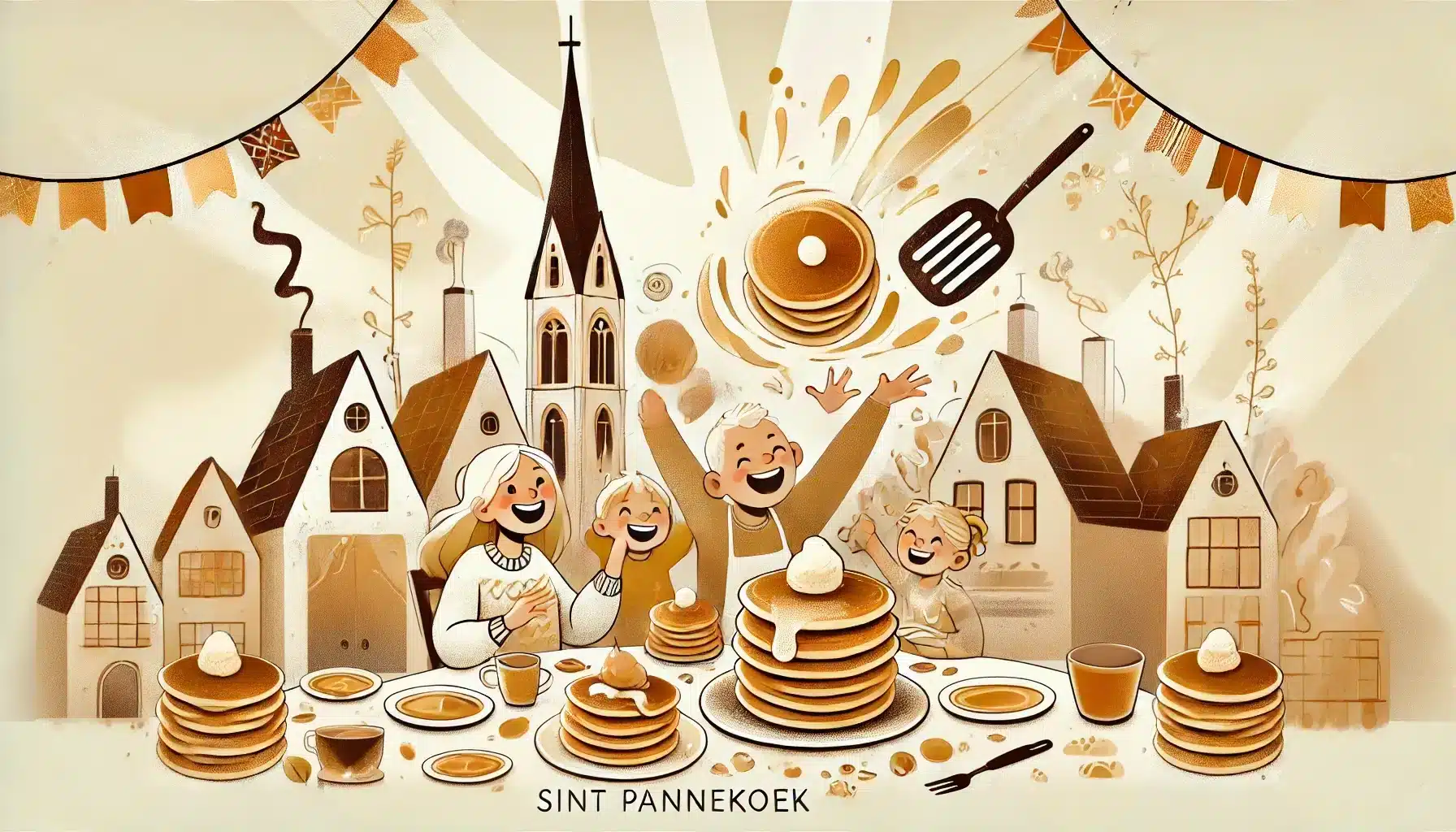What is Sint Pannekoek?
Sint Pannekoek, or Pancake Day, is celebrated annually on November 29th in the Netherlands. This quirky celebration originated from a comic strip in 1986 and has since become a beloved day filled with humor, pancakes, and togetherness. Whether shared among friends, family, or even as part of charity events, Sint Pannekoek is a playful holiday that continues to grow in popularity across the Netherlands.
History and Origin
The story of Sint Pannekoek begins in the school agenda of the comic strip Jan, Jans en de Kinderen, created by Jan Kruis in 1986-1987. In the strip, young Catootje refuses to eat her dinner of beans. Her grandfather, Opa Tromp, cleverly steps in to help. He invents a tale about “Sint Pannekoek,” a supposed old Rotterdam tradition celebrated on November 29th by baking pancakes and placing them on one’s head while wishing each other a “vrolijke en gezegende Sint Pannekoek” (“a merry and blessed Saint Pancake Day”).
What starts as a humorous ploy to get Catootje out of eating her beans turns into a family event in the comic, where everyone joins in to celebrate the fictitious holiday.
Initially intended as a joke, the concept resonated with readers and began to be celebrated in real life. Over time, Sint Pannekoek became a cherished event among students, families, and even community groups. The celebration gained further traction when Jan Kruis founded the Nationaal Comité Sint Pannekoek in 2016 to mark the 30th anniversary of the holiday. He also created a commemorative postcard and stamp, further cementing the holiday in Dutch culture.
Who Celebrates Sint Pannekoek?
- Families: Parents and children celebrate by baking and eating pancakes together, with some even following the tradition of wearing them on their heads.
- Students and Friends: Among students, it’s a lighthearted excuse for a pancake party, often involving creativity and humor.
- Charity Organizations: Some use Sint Pannekoek as an opportunity for good deeds, distributing pancakes to those in need or raising funds for charities.
- Church Communities: Church groups incorporate pancake-sharing events as acts of kindness and community spirit.
- Restaurants and Cafés: Many eateries add pancakes to their menu, sometimes with special deals or fundraising campaigns.
Themes and Slogans
The main theme of Sint Pannekoek is “Togetherness Through Humor,” emphasizing the joy of food, family, and playfulness. Another key theme, “A Tradition Born of Imagination,” reflects its origins in Dutch pop culture. A popular slogan is “Eet, Lach, en Vier!” (“Eat, Laugh, and Celebrate!”), capturing the lighthearted spirit of the day.
Colors, Symbols, and Patterns
Colors
- Golden Yellow: Representing the warm and inviting color of freshly cooked pancakes.
- Brown: Symbolizing the crisp, cooked edges of a well-made pancake.
- White: Evoking powdered sugar, a classic Dutch pancake topping.
Symbols
- Pancakes: Central to the holiday, symbolizing joy, sharing, and creativity.
- Comic Characters: Representing the playful origins of the holiday in Jan Kruis’s work.
- Cooking Utensils: Highlighting the hands-on, participatory nature of the celebration.
Patterns
- Circular Shapes: Reflecting the iconic form of pancakes and the sense of wholeness they bring.
- Syrup Drizzles: Representing the sweet and creative toppings that make pancakes unique.
- Comic Strip Panels: Paying homage to the humorous roots of Sint Pannekoek.
Most Used Hashtags
- #SintPannekoek
- #DutchTradition
- #JanKruis
- #PancakeDayNL
- #PannenkoekenPret
How to Celebrate Sint Pannekoek
- Cook and Eat Pancakes: Follow the tradition by baking pancakes at home. Experiment with toppings like powdered sugar, syrup, or bacon to suit your taste.
- Wear Pancakes on Your Head: Embrace the whimsy by placing a pancake on your head and sharing photos online. It’s a fun way to honor the comic’s original story.
- Host a Pancake Party: Invite friends, family, or neighbors to join in the fun. Share the story of Sint Pannekoek and enjoy the day together.
- Give Back: Use the holiday as an opportunity to help others by organizing a pancake drive or donating proceeds from pancake sales to charity.
- Explore Jan Kruis’s Work: Read or revisit Jan, Jans en de Kinderen to appreciate the humor and creativity that inspired this tradition.
Why is Sint Pannekoek Important?
Sint Pannekoek is important because it exemplifies the power of humor and imagination to bring people together. Born from a comic strip, this lighthearted tradition has become a meaningful way for families, friends, and communities to connect. It celebrates creativity, kindness, and the simple joy of sharing food and laughter.
The holiday also serves as a testament to the enduring influence of Dutch pop culture and the creativity of Jan Kruis, who brought so much joy to his readers. By celebrating Sint Pannekoek, participants honor a tradition that combines fun, nostalgia, and community spirit.
Features
- Funny or whimsical
